Traditions similar to Hoodening
Similar, not the same
Elsewhere, we have offered our definition of Hoodening, although we acknowledge it's impossible to draw a strict line between what constitutes a form of hoodening, and what merely resembles it. We've tried to keep 'variants' on that page (in particular, other groups that use the name hoodening — even though we might disagree with their use of it), and conversely have this page focus on traditions that don't call themselves hoodeners, yet to the untrained eye appear similar. In addition, 'animal guising' (dressing up as some kind of beast) is itself a huge field, ranging from the Chinese lion dance through pantomime horses to recent trends such as cosplay and furry fandom, so we'll concentrate on lesser-known, older traditions… like our own. The diagram below shows some of the characteristics of the better known ones (N.B. it's a rough classification, and there are exceptions).
Soul Caking
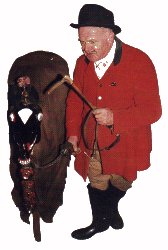
This custom is local to Cheshire, and dates from at least 1820. Despite nearly dying out a few times it now seems to be performed in various areas of the county, such as Halton and Antrobus (Comberbach having disbanded in 2019... but their motto, 'Never Knowingly Over-Rehearsed' lives on, having been enthusiastically adopted by the Hoodeners). Like Hoodening it involves death and resurrection, but is performed at Halloween (All Souls) rather than the winter solstice. The name comes from 'soul cakes', food left out to appease the dead spirits and later given to children or those involved in the play. The horse ('Dicky Dalton' or 'Dicky Tatton', depending on the source) and driver only appear in an interlude. The other characters and the main plot are close to Mumming (King George kills the Black Prince, who is then cured by a Quack Doctor, etc.) so this 'tradition' may actually be a mixture of Mumming and some variant of Hoodening. However, although some have thought the line 'this horse was born at seven oaks' might be a reference to the Kentish town of that name, this is apparently incorrect: there is another Seven Oaks near Antrobus. See also this interesting article by Roy Clinging, and many photos old and new by Duncan Broomhead.
Mari Lwyd ('Pale Mary' or 'The Grey Mare')

In Wenvoe and other villages in Glamorgan, people used to gather on New Year's Eve with a horse (a genuine skull rather than a wooden one, but equally 'hooded' — with a white sheet) to visit local houses and demand hospitality. They would compete with those inside the house both in singing improvised songs and 'debating' (i.e. mocking each other, with Welsh-language poems called pwnco rather like a modern 'rap battle'). Some reports also mention blackened faces, characters called Punch and Judy, and a 'fine' for anyone caught by the horse's teeth. The comprehensive information at FolkWales shows how the custom — once thought to be extinct — still exists in LLangynwyd (Old House Inn has the oldest surviving Mari Lwyd), LLanwrtyd Wells, LLantrisant, Pontypool, and many other locations throughout Wales. It has also been revived by students in Aberystwyth and Morris dancers in LLanfihangel Tor-y-mynydd (archive page), amongst others. There is an active Facebook community and over 30 horses gathered at Chepstow for many years, from Welsh and non-Welsh communities throughout the world, although that is itself controversial — see this article by David Howell on 'who owns the tradition?'. It's amusing to see there was a real horse called Mari Lwyd too. The character has become a meme in popular culture, such as video games.
The Horse's Head tradition in Mumbles near Swansea is distinct from the Mari, having no pwnco or other Welsh-language elements; see also The Mumbles Book (archive page) and Mumbles History (a slightly different version, with photographs). The Welsh Christmas and Torstone pages says that in Pembrokeshire instead of an actual horse's head they used a canvas or horsehair sheet, sewn to form a snout & head and adorned with buttons & gloves for eyes and ears, then stuffed with straw and operated using a pitchfork; it was simply called Y Gynfas Farch (the canvas horse). Iorwerth Cyfeiliog Peate, co-founder of St Fagans,
https://doi.org/10.1179/043087776798240549
A Catalan site has some examples of Mari Lwyd verses with English translations, as well as some more Mari Lwyd verses just in Welsh (both archive pages).
Note: the spelling Mari LLwyd is incorrect, as in Welsh 'llwyd' (grey) undergoes a soft mutation to 'lwyd' after a feminine noun. 'Mari' undergoes a soft mutation itself in some circumstances, so 'The Mari Lwyd' would become 'Y Fari Lwyd'.
There was a Mari Lwyd conference at the Oakdale Institute, St Fagans on 4 March 2006. No proceedings were published, but the presentations looked interesting.
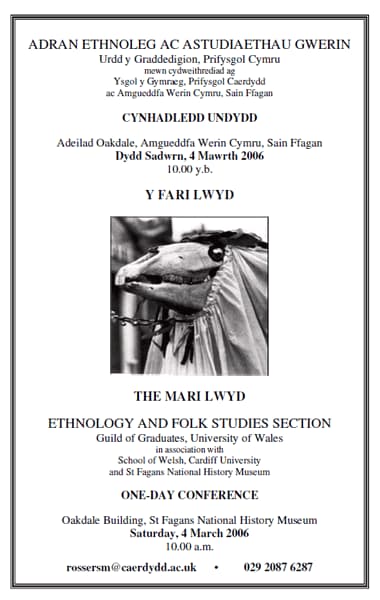
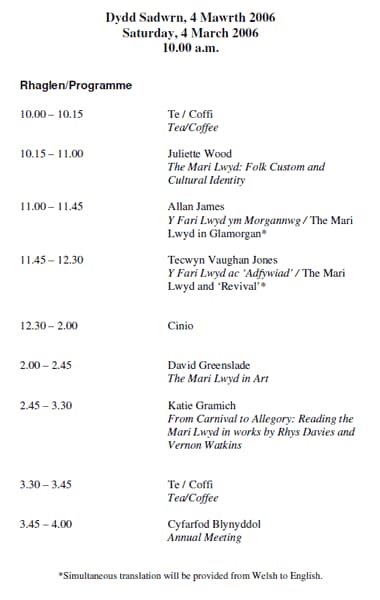
Láir Bhán/Laare Vane
There is an Irish horse called the Láir Bhán ('white mare'), possibly similar to the Mari Lwyd; apparently it was sacred to Muck Olla, the Druids' sun god, and appeared at Samhain. Interestingly, Láir Bhán also appears to be the Celtic word for the Milky Way! What we've seen of the structure, however, looks more like a tourney horse.

The similarly-named Laare Vane on the Isle of Man (and possibly St Kilda?) appeared at both Twelfth Night and harvest time. Both appear in association with wrens, as does the Mari Lwyd. It reemerged (with a slightly altered spelling 'Laair Vane') in 2019, and the description on the Manx culture website has some fascinating bilingual videos where the horse is evidently made from the Trac Mari Lwyd kit, although the photographs show a quite different design closer to the Newfoundland mummering horse template. Allegedly nobody knows who brought the horse out that year.

One site on shamanism has a long and interesting page including references to a white Irish 'Mare of Sovreignty' but it is not clear whether this is the same as above or entirely different.
Schimmelreiter
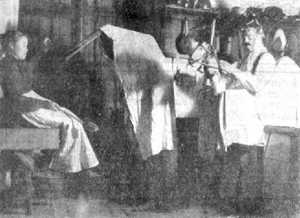
In several parts of Germany there is a custom known as the Schimmelreiter; maybe I ought to say 'customs', as there are several types which seem only distantly related. The essential feature in each case is that the horse is white: this is thought to be derived from Odin's steed Sleipnir in Norse mythology. It is interesting to note that dreaming of a white horse was thought to be an omen of death in both Germany and England (qv A.H. Krappe's 'La Genèse des mythes, 1952).
The group in Westphalia (about which we have least information) would blacken their faces as Hoodeners do, and visit local farmers with a horse to wish them luck and receive food and drink in exchange. Their horse consisted of just a frame with nobody underneath, somewhat similar to a tourney horse. There are some detailed structural diagrams on a page mentioning various locations in a different area south/southeast of Frankfurt.
In many other areas, it seems the Schimmelreiter may often have simply been one of several characters accompanying 'St Nicholas' (a.k.a. Sankt Nikolaus, Sinterklaas, Santa Claus, Klaus, Kloaskerl, Klosbuer, Klausohm, Sunnerklas, Seneklos, Pelzmartel, Pelznickel, Pelze Nicol, Belsnickle, Nickel, Christnickel, Christkindl, Christpuppe, Christmann, Weihnachtsmann, Klingelklaschen, Hans Trapp, Knecht Ruprecht, etc.), who rewarded good children while punishing the bad. The Schimmelreiter would often in turn be accompanied by a Klapperbock (a.k.a. Habergeiß), a feathered, three-legged goat whose lower jaw was hinged and could be slammed shut with a rope, just like a hooden horse. Both Schimmelreiter and Klapperbock (in this case evidently a stork) can be seen in the photograph above from East Prussia.
 Another companion would sometimes be Beelzebub, who also appears in Soul Caking. St Nicholas was often depicted riding a white horse, and would sometimes be called the Schimmelreiter himself. The following site offers quite a good description of how the Schimmelreiter would behave.
Another companion would sometimes be Beelzebub, who also appears in Soul Caking. St Nicholas was often depicted riding a white horse, and would sometimes be called the Schimmelreiter himself. The following site offers quite a good description of how the Schimmelreiter would behave.
Finally, many Germans know the name from the novel (of the same name) by Theodor Storm (description and excerpt here, book available here). The story concerns a 'dykemaster' in Northern Germany who rode about on a white horse, at first as a real human and later as a type of 'guardian spirit' protecting the local communities. It is not clear if Storm invented this legend, or simply made use of it for his book; anyone who knows, please tell us!
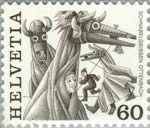 I was once told that there are similar customs in the Black Forest, such as the plays by Hans Sachs (a 'cobbler poet' meistersinger), but have not been able to find any relevant information. There is a lot of information on the Web about German Yuletide customs in general, and hagzissa.de has brief entries for various mythical beasts such as the Schimmelreiter, Klapperbock and more. The Swiss village of Ottenbach has a related custom called Spräggelen (sometimes written as Spraeggele, Räggele, Strättele or Sträggele / Sträggele-nacht, although this last one is more commonly used to refer to a witch character from Lucern, described in Grimm's Fairy Tales). The custom involves stork-like characters called Schnabelgeissen, as commemorated on this stamp (the closest any country has come to featuring Hoodening on its stamps? folklore mask stamps are however quite common, especially in carnival connections).
I was once told that there are similar customs in the Black Forest, such as the plays by Hans Sachs (a 'cobbler poet' meistersinger), but have not been able to find any relevant information. There is a lot of information on the Web about German Yuletide customs in general, and hagzissa.de has brief entries for various mythical beasts such as the Schimmelreiter, Klapperbock and more. The Swiss village of Ottenbach has a related custom called Spräggelen (sometimes written as Spraeggele, Räggele, Strättele or Sträggele / Sträggele-nacht, although this last one is more commonly used to refer to a witch character from Lucern, described in Grimm's Fairy Tales). The custom involves stork-like characters called Schnabelgeissen, as commemorated on this stamp (the closest any country has come to featuring Hoodening on its stamps? folklore mask stamps are however quite common, especially in carnival connections).
Symondsbury's pony
The mummers at Symondsbury in dorset have a play incorporating a horse, or rather a pony, called Tommy. He made a guest appearance at the 2023 Maidstone exhibition, where James Frost commented that he felt this was almost the 'missing link' (between Hoodening and other traditions), as he plays a significant role in the play rather than just being a supernumerary character.
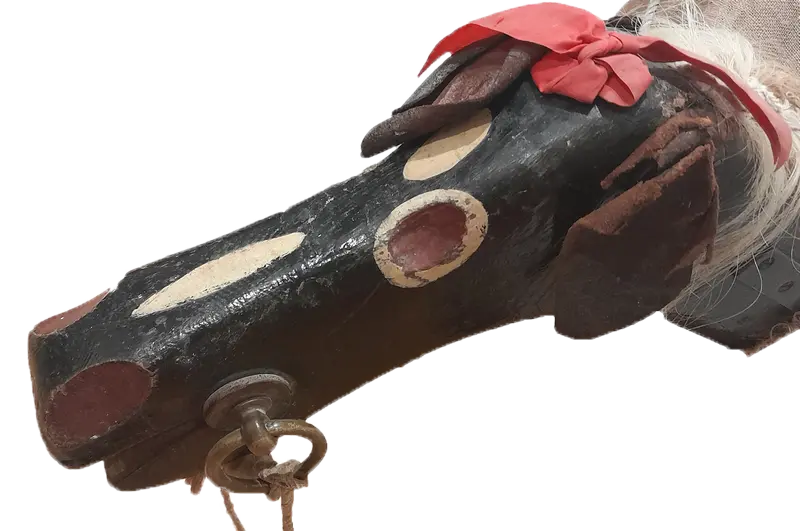
Old horse/Owd Hoss
The Dore to Door site has an interesting description of the Old Horse of Dronfield in Derby, reproduced below verbatim (with permission).
This Old Horse
The Old Horse was a traditional folk play performed locally at Christmas and the New year. It was an unaccompanied ballad chanted by several men and enacted by one man dressed in a black cloak topped by a symbolic, stylised horse's head.
The group would visit farms, public houses, and the houses of leading citizens. As well as performing in Dronfield, neighbouring villages were also visited including Dore. At the end of the performance a hat would be passed round, or drinks would be offered.
In later years the horses head was a large, heavy, fearsome papier mache construction formed around the skull of a blind pony killed while failing down Holmely Quarry. It was donated by the Lucas family. This head was fixed onto a broom handle so that the operator, enclosed in the material, could flaunt and flourish the head and snap the jaws as the story unfolded. Gallant but abused the horse falls to the ground in doleful death throes, then rises again in resurrection and celebration.
This custom survived well into the twentieth century, and it may be that there are still some alive who remember the tradition.
Like many folk customs The Old Horse was an irreverent occasion accompanied by heavy drinking and a great deal of noise. On at least one occasion it resulted in tragedy.
In January 1869 it was reported in the Derbyshire Times, that a man was lost on the moors. 'A number of persons, including James Greenwood and Thomas Oxley, had left Dronfield the previous Thursday to go to Barlow and neighbouring villages, to act in what is well known in Derbyshire as the 'Old Horse'.
'On Friday evening Greenwood and his comrades visited the Bulls Head Inn, Calver. Words of an angry character are said to have passed between Greenwood and Oxley, which ultimately ended in a fight, and Greenwood leaving the party, as it is supposed, to go home. He was last seen as late as 12 o'clock at night, and being defective in sight and also worse for liquor at the time he left the Inn, it is supposed that he may have (being a stranger) missed his way, and perished on some part of the moors, or otherwise have got into the river Derwent, which was much swollen by the heavy rain falling at the time.'
The paper went on to describe his appearance 'He is of middle stature, with a scar on his left cheek near to the jaw, and had on two coats, one of fustian and a dark overcoat mended at the elbow of one of the sleeves, dark trousers and a pair of light clogs…'
The next issue of the Derbyshire Times reported that his body had been found in the Derwent about a quarter of a mile from the public house.
Ed. The Dore Village Society has recently managed to transcribe a copy of the performance.
The custom seems to have continued until 1973, then 'rested' due to a lack of 'young blood', but then interest was rekindled in 2016 and again in 2022, resulting in an article in Great British Life (and a remarkable new horse, somewhat influenced by the film Alien, we suspect!).

Old Ball
There is little information on Lancashire's Old Ball (a custom often performed at Easter and possibly related to Pace-Egging; see also Wikipedia) but the 1867 book Lancashire Folk-lore does contain some descriptions which sound very similar to hoodening: a horse's head (sometimes but not always a skull) on a pole, with snapping jaws, nails for teeth, a sack hiding the operator, a tail, and a team of 5-6 people taking it around to entertain with music and horse-play. There is an imaginative depiction in the modern novel Mist over Pendle by Robert Neill.
Plough jags
Visually one of the most unusual horse costumes is this Lincolnshire combination of a tourney horse with a 'worn' head: two beasts for the price of one. It was possibly made from a sieve (see this detailed description), and the term 'sieve horse' is also found, but can be confusing as some types of the Schimmelreiter use sieves in a quite different structure. As with hoodening, they seem to have "toured local farms, houses and pubs, performing a short play and song", gradually declined in the early 20C, and found renewed energy some decades later, particularly at Coleby.
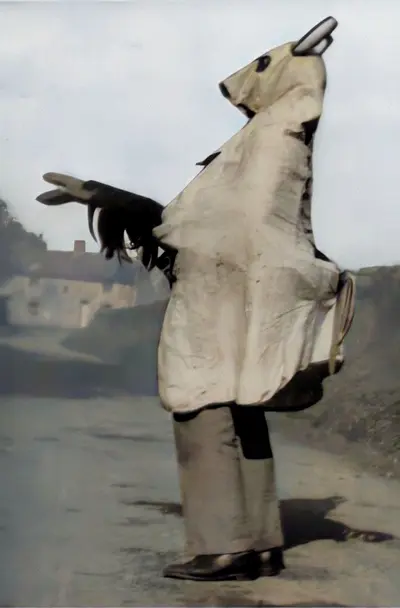
Morris beasts
When we start to explain to people what we do, a common reaction (in the UK) is "oh, so something like morris dancing?", which is rather weird, as there's no connection or similarity other than that both are called 'folk traditions'. Maybe it's simply that the general public aren't aware of any folk traditions except morris dancing. Anyway, there's lots of information online about the morris and other folk things so we won't go into them here — those interested can read more at Wikipedia, while StreetSwing site has a good description of the history of the Morris, and there are lots of old (archived) links on Chris Clarke (Gnasher)'s site.
Having said all that, there are some morris sides who have a 'supernumerary' character that is a beast, such as dragons, stags/deer, rams/goats, badgers, foxes, birds, or horses/donkeys/unicorns: see the Illustrious Order of Fools and Beasts or the (rather outdated) list of over 70 at the Morris Ring Animal Archive, summarized in the two images below.


Yateley Morris have a rather unique 'highwayman's' horse. Many other weird & wonderful beasts can be seen at folk festivals, such as Sidmouth (where there are even Horse Trials sponsored by Aardman Animations, of Wallace and Gromit fame), or previously at Banbury (celebrating the rhyme 'ride a cock-horse to Banbury Cross'). There is also a well-illustrated article on Tradfolk, which is not limited to morris beasts.
Mummers across the pond
In Newfoundland and Philadephia they have a tradition known as the mummers' parade — although one should say 'traditions', because they are quite different from each other. Philadephia's mummers' parade is huge, like the Rio Carnival (10,000 people, marching bands etc.) and horses play no part. The Newfoundland custom, however, (note: they call it mummering, not mumming) involves winter visits to local houses in disguise, as with many British equivalents. The disguise itself is crucially important: the aim is to be disguised so well that even one's neighbours struggle to guess who is inside. There have occasionally been problems leading to it being banned (again, not unheard of in the British Isles), and there's even a short horror film showing the terrors of 'death at the hands of a mummer', but recently it's tended to focus on a kid-friendly event, with horse-making workshops, downloadable templates and YouTube 'how-to' videos:
Their horses are sometimes called 'jannies' (and many other names) — and the image and construction is often furry, even cuddly.
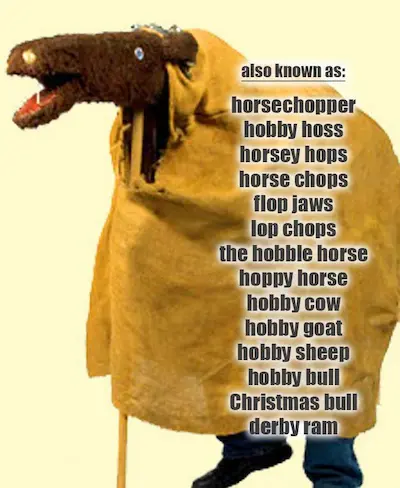
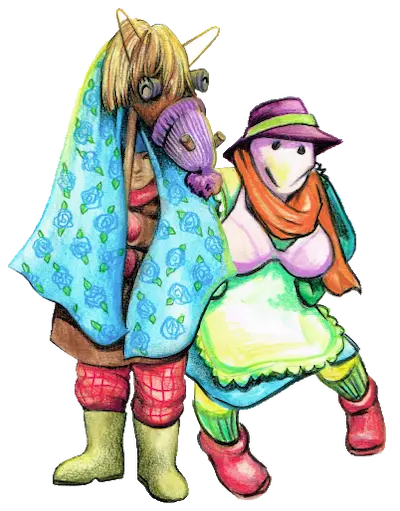
In 2017 our George joined a radio discussion with Ryan Davis of the Mummers Festival, about the various traditions:
HobbyTourney Horses
The word 'hobby horse' is even harder to define than hooden horse, and for that reason we tend to avoid it, except with reference to the horsehead-pole-wheels variety often used as a children's toy, or in a totally serious Finnish showjumping sport — see the page on the horses themselves.

Morris teams sometimes use the term to refer to tourney horses, which generally consist of a frame with a horse's head at the front and a tail at the back, draped in fabric and worn about a dancer's waist. Three famous examples are the one in the Betley Window, the one shown in the dancers at Richmond painting, and the unnamed horse's head used in the Abbots Bromley Horn Dance. Similar beasts can be found throughout the world, as shown in the examples below from India and the Basque country.
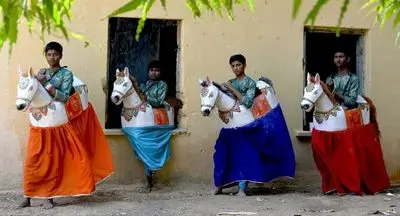
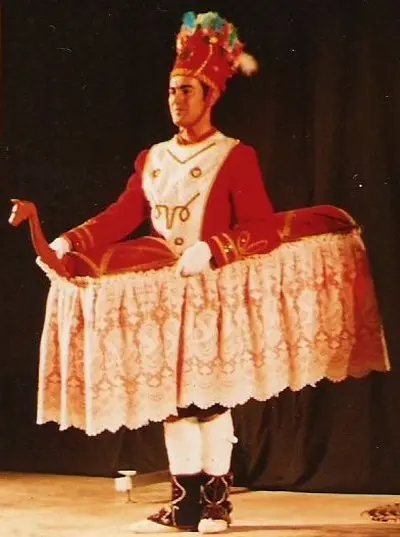
There is a Polish custom involving a tourney horse, which apparently symbolizes one of the Tartar invaders of the 13th century. For more information see the Polish Lajkoniks. However, this is a summer custom. In winter, the Poles have jasełka (nativity plays) or kolędowanie (carolling) which in certain areas include a hooded & horned aurochs called the Turoń (better pictures of the beast itself on this Polish page); its behaviour seems remarkably similar to that of a hooden horse in many respects.
Whirling Osses
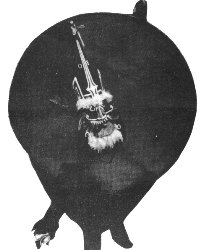
The West Country is known for its big, dancing/spinning horses — a particular type of tourney, some of which (but not all!) are commonly called 'osses — including the Padstow 'Obby 'Oss (used at May Day celebrations; the original Old 'Oss is alleged to have a history of four thousand years, while the Blue Ribbon 'Oss was added in the 1890s by the temperance movement), the Minehead Horse, the Earl of Rone, and the recent, albeit now dormant, Black Dog (not a horse!).
Hobby Horses and Associated Rites provides an excellent description of tourneys in the British Isles, including Padstow and Minehead. Banbury Town Hobby Horse is also worth a look: it includes a 'make your own' section. Here is a nice old photo of a whole herd of tourney horses at Gainsborough in 1927.
Other equine characters found around Europe include the Faksi Christmas spirit from Setesdal in Norway, the Danish Hvegehors (and possible also two similar customs known as Bette Fanden and Hvidemær =? white mare), the Faroese jólhestur (known to have two clacking wooden jaws), Norwegian Arnaldus Jolahest, Icelandic vikivaki (tourney horse), and an amazing nine-person 'Poulain' (foal) found in Languedoc along with a bull and a wolf.
This site had an interesting story, originally contributed by David White, which I again reproduce below verbatim (with permission). This is an example of a shaming ritual more generally known as skimmington, rough music, or charivari.
The following extract is taken from an article entitled 'Ancient Wiltshire Customs'' by F.A. Cannington, published in the very first copy of the Wiltshire Archaeological and Natural History Magazine published in 1853.
The Wooset
In the villages near Marlborough, this is a mock procession got up by the village lads, when conjugal infidelity is imputed to any of their neighbours. At a little before dusk, a blowing of sheep's horns and a sounding of cracked sheep bells may be heard about the village, and soon afterwards the procession is formed.
I saw two of these Woosets; one in the year 1835 in Burbage, the other about five years after at Ogbourn St George. The procession was in each instance headed by what is called 'a rough band'' which in the latter instance was numerous. Some beat old frying pans, others shook up old kettles with stones in them; some blew sheep's horns, others rang cracked sheep's bells, and one of the performers was trying to extort music from a superannuated fish kettle, by beating its bottom with a marrow bone. Four more carried turnips on long sticks, each turnip being hollowed out very thin, and the features of a face cut thinner still on it. and a lighted candle put in the inside. These were followed by a person bearing a cross of wood of slight make, and seven feet highboy the arms of which was placed a chemise, and on the head of it a horse's scull, to the sides of which were fixed a pair of deer's horns, as if they grew there; and to the lower part of the horse's scull the under jaw bones were so affixed that by pulling a string, the jaws knocked together as if the scull was champing the bit; and this was done to make a snapping noise during pauses in the music.
This procession repeated on three nights following, when it goes past the houses of the supposed guilty parties; it is then discontinued for three nights; resumed for three nights more, discontinued for another three night and then resumed again for another three nights, and then it concludes. As those of you familiar with the Wiltshire dialect will know, the 'W' at the start of a word followed by an 'o' was silent, so the thing was commonly called an 'ooset'.
Although we are now moving away from horses, the Straw Bear Festival is well known, and in the same vein, Dave Eyre kindly sent me the following information on the Pyrenean 'Bear Dance', based on Violet Alford's 'Pyrenean Festivals Calendar Customs, Music and Magic, Drama and Dance', pub. Chatto & Windus, London 1937:
Alford suggests that the Bear Festival is found all around the Pyrenees. The index devotes 20 pages to it, in three separate entries. She describes (pp 16…) the festival in Arles-sur-Tech which is in what they now call Catalunya Nord (the Catalan speaking part of France):
Description
The Cobla (band) appears, a strange company which stops outside the Mayor's House where he gives a discourse in Catalan. He is accompanied by a man/woman… (Rosetta)… there is a dance… sportsmen with muzzle loaders… (modern day equivalent 'trabucaires')… a dance… everyone goes out to a local meadow… other figures… painted faces… wooden noses… garlic leaves as hair… a second face on the back.(imagine a French legionnaire's headdress with the face painted on the shade bit at the back)… dressed in women's skirts… below which are 8/10 cowbells… little hobby horses (these were left over from last year's carnival (Carnival is the period from Jan 1st to… err, not quite sure… Easter or Lent)…
Now a head appears above the bank dark and shaggy with great, bloody teeth. A shambling body rears up… shots ring out, children scream, men with poles aid the orator of the morning and after ten minutes the beast is caught alive, chained and led back into town.
The Cobla repeats the bear tune a hundred times and as it approaches the cry goes up 'L'ous, l'ous!' (modern day Catalan spelling 'Os'… cf. Latin 'ursa'), The bear eventually becomes a dancing bear and takes a drink but… desires Rosetta — the man/woman referred to at the start.
The bear is led to a 'cave'… the beast breaks loose seizes someone out of the crowd who amid shrieks is dragged into the lair… The bear enters too… door is closed… they are shut up together… all passes off peacefully and the bear offers his lady sausages, cakes, and white wine. Things move to their appointed end… they seat the beast in a chair… his trainer begins to dance… a cloth, a basin, an apple, a hatchet, come out of the crowd… the beast is shaved… using the apple for soap… the beast leaps again upon Rosetta… a shot rings out… his great body falls helpless to the stones… a moment's silence… a dance around the bear… bear is carried away to dirge-like music.
Explanation
'Without a shadow of doubt here is the ancient Spring Rite faithfully carried out each year by the modern Carnival Committee of Arles-sur-Tech'.
… founded primarily on a dread of hunger it is made up of magical doings by means of which helpless man sought to control the forces of Nature. Things old and weak must be done away with, things new and strong must take their place. The well-being of everyone was bound up with the Kingship… he bore his all-important burden for a space of time only. When signs of age appeared… he disappeared to give place to another, younger and stronger and therefore more magical in fertilizing powers. The king is dead, long live the king… and growth, warmth, and fecundity continue as before.
Often the victim was a divine being… the basic idea — get rid of last year's weakening forces, replace them with forces renewed and fresh, that with them the force of humans in the village beasts in the corral, vegetation everywhere… is one of the foundations of primitive man's make-up.
She then goes on to argue a difference between initiation rites (boy into man) with communal rites (as she argues this is)…
Finally… 'When we look at our divine bear yearly impersonated by a modern Catalan workman we find all the essentials to the main rite in their places… the procession through the town, the inevitable man-woman, the disguises, the bells, the ritual death, the drink, the license, — the old fertility rite if ever there was one'.
She goes on to describe similar festivals at other places.
The Derby Mummers perform a play with the Old Tup / Derby Ram, whose origins seem very — and verifiably — old; see also folkplay.info. Some other Mummers at Tresham in Gloucestershire in the late 19th century apparently used a hollowed out swede on a pole, which they called an 'ox's head' (the ox was called Broad); according to this website, other villages had more expensively constructed Bull's Heads. The Dorset Ooser is actually a human head with bull's horns, and it is interesting to note that its owner Thomas Cave later became Vice-Principal at Wye College, whose students found two of the Kentish hooden horses.
Others — further afield
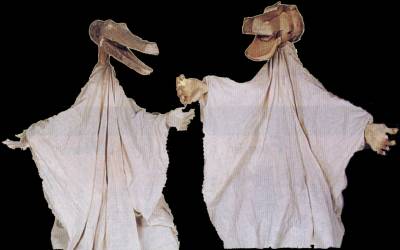
A festival in Amiens (France) in December 2001 included a play featuring some creatures from Mali which look remarkably like hooden hippos and crocodiles: judge for yourself! (Click here for a brief description in French).
There are numerous customs in Japan with vague similarities to Hoodening, such as Kadozuke (qv JStor, Hachinohe Emburi or Jane Marie Law's book Puppets of Nostalgia: Life, Death and Rebirth of the Japanese Awaji Ningyo Tradition, but obviously none which are directly related.
Sacred Spiral has a brief mention of Were-Wolves and Tibetan dancers in conjunction with Hodening [sic]. Coincidentally, a friend on a visit to Lhasa managed to capture a snapshot of the 'Hooden Yak' shown here.
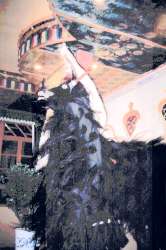
Further reading
On this page, we have only scratched the surface... some suggestions for finding out more are shown below.
- Animal Guising by James Frost — the most recent, highly praised book on this whole area.
- Ritual Animal Disguise by Dr E. Christopher Cawte — known as a classic, if somewhat dated now, as well as rare & expensive.
- Crossing the Borderlines: Guising, Masking and Ritual Animal Disguises in the European Tradition by Nigel Pennick — rather idiosyncratic...
- The English Folk Play site operated by the Traditional Drama Research Group at the National Centre for English Cultural Tradition (University of Sheffield) includes information on e.g. the Alex Helm inventory of about 3,700 records on British folk plays, Morris dancing and related traditions.